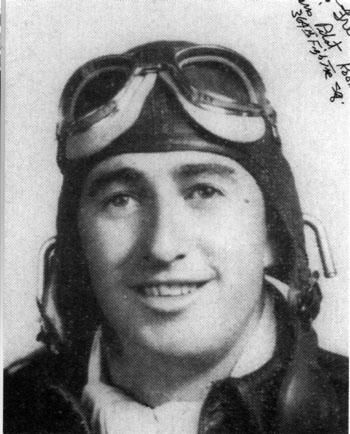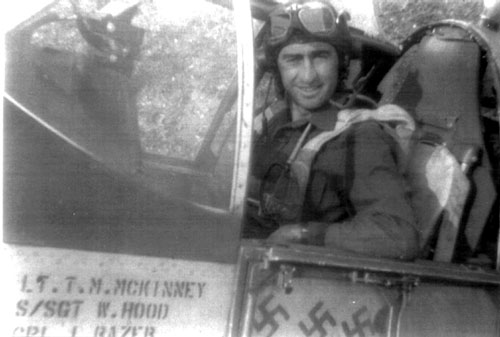
Captain Tom Morris McKinney
364th FS, 357th FG, 4 1/2 victories.
This interview was in response to a list of questions provided to Morris. We would like to thank Morris for doing this great interview!
My father and two sisters moved to Simpsonville, South Carolina, after the death of my Mother. I was nine years old. I lived in Simpsonville during my remaining teen years. I graduated from Simpsonville High School. I volunteered for the Army Air Corp in March 1941 in Greenville, South Carolina.
My first assignment was Mechanic Trade School in New Orleans, Louisiana. I graduated two weeks after Pearl Harbor. Following graduation, I was assigned as a mechanic on B-24s in the 30th Bomb Group, 21st Squadron, in Muroc, California. The Rogers Dry Lake Unit moved to March Field, Riverside, California, early in 1942. I applied for Flight Training and was accepted. My first assignment was headed for Pilot Training. I graduated as a Flight Officer from Luke Field in the Class of 43C. Following graduation, I was assigned to the 357th FG, 364th FS at Tonopah, Nevada. I learned all about P-39s after flying 500 hours. They required a soft touch and some respect. The Aircobra would bite back–too many in our group bought the farm. Sad to say, the very first cruise for me was aboard the “Queen Elizabeth” on our way to England. The North Atlantic was wet and stormy, but I avoided seasickness during the five day trip.
On leaving the “Queen” by ferry, I was shocked at the size of the ship. It had some 20,000 troops. No wonder it was fair game for U-Boats. We traveled by train from Glasgow, Scotland to England. Our first base was Raydon Wood. It was all new with lots of mud and no aircraft. It was just a short stay in the 9th AF before transferring to the 8th at Leiston. There we saw our Mustangs for the first time-all five of them. They were P-51B’s, and each pilot flew five hours around England feeling out the new fighter. It was a dream to fly compared to the P-39. It did a super job for what it was intended. Just ask any bomber pilot or crew member who saw them in action over Berlin. Even Goring was in awe about the “Little Friends” doing air cover deep in Germany. After the war, he reported that he knew then that the air war was lost when he saw the Mustangs.
An Me 109 POW pilot on our base in Florida after the war stated that a pilot would be willing to make the supreme sacrifice in the Mustang.
After those long missions, I “retired” to a double bed I had bought in the showroom window with the first English pounds I spent. I had the comforter and all the accessories. When I left the group for state side, I offered to sell it at a terrific discount. No takers at any price. Later I learned that John Storch claimed my bed. I hope he slept as well in it as I did. I suppose my second purchase was fish and chips. Those were the extent of my purchases with English currency. It always seemed inferior to the “greenbacks” to me.
I had no training on the K-14 gun sight and had no encounter after receiving it; therefore I can’t evaluate the K-14. I feel that most kills were with the ring and bead sight. It was more like open iron sights, yet very dependable. The closer your range to the target with either sight greatly increased the accuracy of the 50 cal.
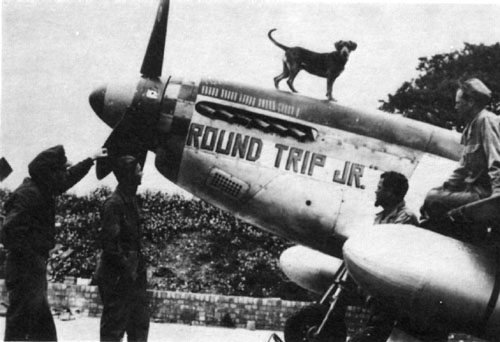
Capt Morris McKinney, his plane, mascot “Jamaica” and crew Sgts. Hood, Bazer and Burleson.
I flew a total of 74 missions, 301 hours, in the model B, C, and D Mustangs. All were flown in “Round Trip” and “Round Trip Jr”, a name selected by my ground crew and myself. I cannot remember ever flying another Mustang other than Round Trip. One Time it was down for an engine change after another pilot used war emergency boost and blew the stacks off the engine-some horse power, I suppose. I never broke the wire, but I’ve always felt that it had some more boost. My previous mechanic training and work on B-24’s taught me to never abuse the Merlin. I suppose all of us had guns jam in the B models.
On my first encounter, and all alone, one on one with an Me 109, I lost 3 of 4 guns in three head-on attacks. The CO from the 363rd FS called me off to escort him back to England because his Mustang was barely flying after taking several 20 mm shots from a 109. Top speed home was 140 mph, slowest flight ever on return for me. His Mustang had been “vented” real well along fuselage from cockpit to tail. After I broke off, the Me 109 trailed us for miles, and I am sure he was asking what is going on with those two pilots? I was worried that I had only one gun with which to protect the shot-up Mustang.
Finding myself in a formation with 50 Mustangs crossing the North Sea to do battle with the Luftwaffe and knowing most every pilot by name made for me the most memorable and proudest of all my experiences. Men who knew that some would not return yet willingly gave support to each group member even if it meant the uncertainty of returning to Leiston. To witness a pilot and friend go down was the toughest part to cope with for me. Some could not handle it too well. A trip to the pub or officers club seemed to help.
I feel that the sighting of the FW 200s taking off from a field in France is another of my most memorable combat missions. The Group was returning from a bomber escort run into Southern France on one of my first missions. G V Davis, my flight leader, spotted aircraft taking off at 8,000 ft. below. Our flight consisted of three P-51s and I was flying #3 as element leader. It was almost solid overcast as we dove through a small hole in the clouds when Me 109’s were seen at 5,000 feet. I was told to engage the fighters. When I broke out of the dive, they entered the overcast and did not return. Why? The three airborne Condors were shot down and burned near the field. Several others were parked around the Airdrome, but after Ack-Ack came into play, we pulled away and circled a couple of times before heading for Leiston. I had seen my first German planes – big ones! They were guiding U-Boats to our convoys in the Atlantic. Maybe a convoy was saved because of it. What a show for my first encounter.
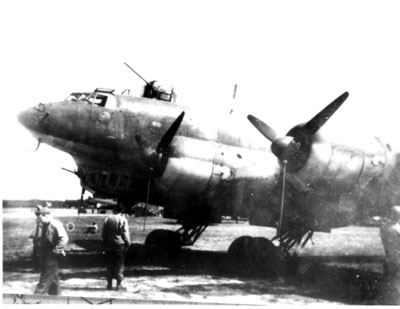
FW 200 “Condor”- These were encountered by Morris’s Flight on 5 Mar 44.
I saw Me 262s on one of our escort missions. We saw it as a demonstration since they were much higher and faster and made no passes on the bombers. I remember the long contrails they left. They lingered around much longer than the trails our bombers made.
One other German “shocker” was the V-1 Buzz Bomb. My ground crew saw one crash near our base and believed I would be going against robots instead of piloted aircraft. They had a point even though it never occurred.
The Germans had the delivery system to deliver atomic weapons to England and even an aircraft by Messerschmitt that could reach New York and Washington and return to France. This plane made the flight over New York and returned undetected. Thanks to the 8th AF, the Norwegian saboteurs and the RAF, the A Bomb was derailed a number of times. This prevented us from having to deal with it as did Japan., It was surely a close call.
Most often I flew with members of my flight and the 364th Fighter Squadron. Our first flight of four pilots was G. V. Davis – Flight Lead, T. L. Harris – #2 man, Tom McKinney – #3 leader and Morris Stanley – #4 Tail End Charlie.
We all trained together state side as Squadron units at different bases. We were together as a Group with the three squadrons, at Leiston, for the first time since Tonopah.
Most of my combat flying was with our Squadron pilots. We knew them well and their aircraft names also. Of course, it was a relief to join a bomber or fighter if returning to England alone. I was alone only twice for a short time. It was a great feeling when I saw other Mustangs since I was out of ammo on one occasion. What a mistake- it never happened again. Once while alone I spotted Hurry Home Honey, and Pete and I flew in a snow storm for some distance before reaching England. It seemed that the flakes were moving past us on a horizontal plane. Peterson missed the snow scene, for he was on the gauges in solid IFR conditions.
My flight after receiving it when Davis failed to return included: Tom McKinney – Flight Leader, Hank Pfeifer – #2 Wingman, Baron – #3 Element Lead, and George Fandry – #4 Wingman.
On entering the briefing room on June 6, 1944, we were told that the paratroopers were jumping at the moment in France, and that this was the BIG PUSH! We left our base before first dawn expecting to enter into the largest air battle ever. We were in total shock when no enemy aircraft showed. Why?
Some years later a Me 109 pilot told me that his unit was at Calais, France, waiting on orders that never came. It was strange that they had all day to fly a short distance to Normandy for the show, yet chose to sit it out elsewhere. He did alibi in believing that Normandy was a decoy, and that the invasion would be in the Calias area. I’m sure we could have been found easily enough since we were all zebra striped for identification. We returned to base after a long day to learn that Le Roy Ruder of the 364th was the only pilot lost on the mission- another empty bunk to cope with. I flew two long missions on D-Day.
I flew with all 357th FG pilots as a group on escort missions, but more often we flew with squadron members. I will list some here: GV Davis, John Storch, Tommy Hayes, TL Harris (Little Red), Ray Sparks (Sparky), CD Sumner (Speck), Mark Stepelton, Ben Elliot, Hank Pfeiffer, George Fandry, Morris Stanley, Jack Warren, Pete Peterson, Le Roy Ruder, Bud Anderson, Chuck Yeager, Glen Hubbard, Col. Spicer, George Currie, Ed McKee, and Bill Reese.
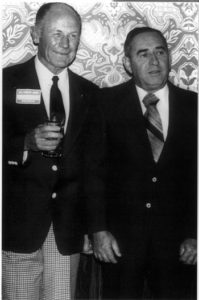
Chuck Yeager and Morris at a 357th FG reunion
My faithful ground crew: Bill Hood – Crew Chief, Irv Bazer – Asst. Crew Chief, and Sgt. Burleson – Armorer.
Not one abort in 74 missions due to mechanical problems. Quite a record!!
To my ground crew and to all 357th pilots, I am proud to have been a part of the most dedicated and patriotic group of men I have ever known. Thanks for letting me be a member. It’s a great honor to have served with you.
Thanks to Charley Campbell for locating Ray Sparks for me following the 1973 reunion. We spent many hours fishing the Wabash River and gathering Morel mushrooms in Indiana. The 36 pound flat head cat I caught still remains the largest fish on my record. Fish filet and mushrooms makes for a super treat believe me.
After seeing the move Lilac Time in 1928, I decided instantly that I would be a fighter pilot one day. Gary Cooper and Colleen Moore starred in the film. I was eight years old at the time. The theme song, Jeannine, I Dream of Lilac Time, has remained with me until today. It was after the war that I met my Jeannie, by the name of Mary Jane. We have one son, Stan, and two grandsons who are 9 and 6. We fish when we are together and already these two exaggerate about the size of the fish and stories they tell. They will be true fishermen I suppose. Everyone is happy with no regrets. I am so lucky at 80 years old!!!
